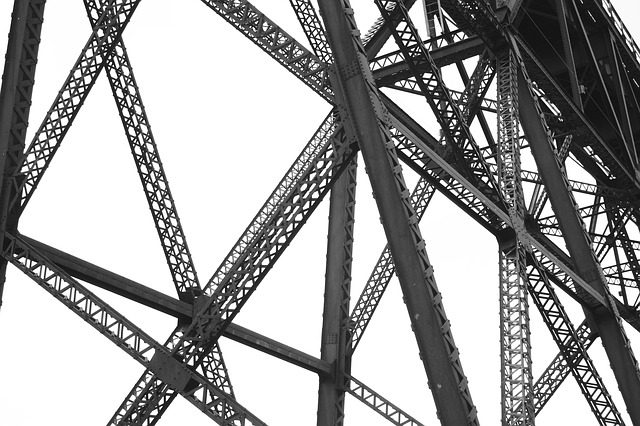Types of steel for construction

|
Contents |
[edit] Introduction
Steel is one of the most commonly used materials in civil engineering due to its high strength, durability and relatively low cost. It is an alloy of iron and a number of other elements including carbon. Manufacturers produce different types of steel by varying the type and quantity of alloy components, as well as the production process and the manner in which they are worked.
The different mechanical and physical properties that are required for the specific application determine the type of steel that is produced. Grading systems identify steels based on properties such as:
- Elasticity.
- Density.
- Melting point.
- Thermal conductivity.
- Strength.
- Hardness.
There are many different types of steel, broadly categorised according to their chemical composition into the following groups:
[edit] Carbon steel
Carbon steel is a combination of iron and carbon. The percentage of carbon is varied to produce different qualities of steel. The higher the level of carbon, the stronger, but more brittle the steel tends to be:
- Low carbon steel is easily workable. Wrought iron is a form of low carbon steel, often used for decorative ironwork such as railings and gates.
- Medium carbon steel can be used for structural steelwork.
- High carbon steel is often used for the manufacture of tools and high-strength wire.
- Ultra-high carbon steel is non-malleable, hard and brittle. Cast iron is a form of ultra-high carbon steel.
[edit] Alloy steel
Alloy steels are produced from carbon steel and one or more alloying elements. These additions can improve the mechanical properties of the alloy. For example, steel combined with manganese is very hard and strong, while steel combined with aluminium is more uniform in appearance.
Weathering steel (also known by the trademark COR-TEN steel) is a form of high-strength, low alloy steel, chemically composed to form a stable, rust-like appearance that can resist corrosion and abrasion, by forming a protective surface layer, or patina.
Steel combined with chromium (and sometimes nickel) is called stainless steel. Stainless steels do not generally form rust on their surfaces and do not discolour. The level of chromium is typically between 10-20%, with a level of 11% making the steel around 200 times more corrosion resistant than steels that contain no chromium. Stainless steel can be classified into three main categories based on their metallurgical structure: austenitic, ferritic and martensitic. For more information, see Stainless steel.
Tool steels are steels containing varying amounts of tungsten, molybdenum, cobalt and vanadium that have properties that are particularly suitable for forming tools and can be used to create moulds for injection moulding. They are abrasion, impact and/or corrosion resistant.
[edit] Galvanised steel
Galvanisation can be used to help prevent steel from corroding. This involves coating steel in zinc. The coating of zinc prevents corrosive substances from reaching the base metal. The zinc also acts as a sacrificial anode, meaning that if the coating is scratched, the remaining zinc will still protect the exposed steel.
[edit] Related articles on Designing Buildings
Featured articles and news
Architects, architecture, buildings, and inspiration in film
The close ties between makers and the movies, with our long list of suggested viewing.
SELECT three-point plan for action issued to MSPs
Call for Scottish regulation, green skills and recognition of electrotechnical industry as part of a manifesto for Scottish Parliamentary elections.
UCEM becomes the University of the Built Environment
Major milestone in its 106-year history, follows recent merger with London School of Architecture (LSE).
Professional practical experience for Architects in training
The long process to transform the nature of education and professional practical experience in the Architecture profession following recent reports.
A people-first approach to retrofit
Moving away from the destructive paradigm of fabric-first.
International Electrician Day, 10 June 2025
Celebrating the role of electrical engineers from André-Marie Amperè, today and for the future.
New guide for clients launched at Houses of Parliament
'There has never been a more important time for clients to step up and ...ask the right questions'
The impact of recycled slate tiles
Innovation across the decades.
EPC changes for existing buildings
Changes and their context as the new RdSAP methodology comes into use from 15 June.
Skills England publishes Sector skills needs assessments
Priority areas relating to the built environment highlighted and described in brief.
BSRIA HVAC Market Watch - May 2025 Edition
Heat Pump Market Outlook: Policy, Performance & Refrigerant Trends for 2025–2028.
Committing to EDI in construction with CIOB
Built Environment professional bodies deepen commitment to EDI with two new signatories: CIAT and CICES.
Government Grenfell progress report at a glance
Line by line recomendation overview, with links to more details.
An engaging and lively review of his professional life.
Sustainable heating for listed buildings
A problem that needs to be approached intelligently.
50th Golden anniversary ECA Edmundson apprentice award
Deadline for entries has been extended to Friday 27 June, so don't miss out!
CIAT at the London Festival of Architecture
Designing for Everyone: Breaking Barriers in Inclusive Architecture.
Mixed reactions to apprenticeship and skills reform 2025
A 'welcome shift' for some and a 'backwards step' for others.
























